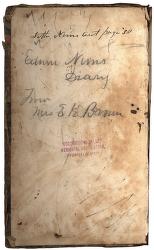|

"Haying in Fuller Swamp"

"Betty at the Churn"

Two children feeding hens

Excerpts from Edwin Nims' Agricultural Diary
|
Summary and Objective
Students will understand through art, diaries, and literature, that children were expected to perform seasonal chores vital to a family's survival in a 19th century agrarian society.
Teaching Plan
Step 1.
Pre-lesson Activity: Children will learn the difference between primary and secondary source documents by: 1. creating a primary source document of their 21st century chores 2. creating a secondary source document of 20th century children's chores from 50-80 years ago by interviewing a parent about chores they remember their parents and grandparents telling them about having to do when they were children. Students will discuss how their present-day chores differ from those of their grandparents and great-grandparents. They will also discuss "male vs. female" chores then and now and the age when a child was expected to take on adult chores. They will also note how certain chores are dictated by the seasons, such as shovelling snow or weeding the garden.
Step 2.
Students will click on to view the following paintings depicting 19th century agrarian chores: 1. "Haying in Fuller Swamp" c. 1855 by George Fuller 2. "Betty at the Churn", by Frances and Mary Allen and 3. "Two Children Feeding Hens", by the Allen sisters. The students will note any differences between the sexes regarding chores and the relative ages of children in the pictures. In addition, they will also note what seasons appear in the outdoor chores pictured and why Betty may be standing near a window to perform the indoor chore,churning butter.
Step 3.
Students will click on "Excerpts from Edwin Nims' Agricultural Diary", p. 34, 37, and 44 to explore a primary source document from the Expansion Period detailing haying and other farm chores performed by men and boys in the 19th century during the summer and early autumn months. Students will discuss if they feel 10-year-old boys could/could not perform the chores mentioned in Edwin Nims' diary and why chores are seasonal in an agrarian society.
Step 4.
The students will use literature to develop an understanding of 19th century Civil War era summer and winter chores performed by boys and men by reading excerpts from Laura Ingall Wilder's "Farmer Boy": Chapter 25, "Threshing", and Chapter 27, "Wood Hauling". They will compare/contrast the tone of the authors regarding farm chores from Edwin Nim's Diary with those presented in "Farmer Boy". For example, do they feel Edwin Nims would regard the sound of threshing hay to be like Almanzo's "marching to the music on Independence Day"? Do they think Edwin Nims would go off "whistling to do his chores" after a full day of threshing? The students will also consider the dangers 10-year-old Almanzo faced stacking and hauling cordwood in the winter and compare/contrast his father's comment: "Accidents will happen, son" with that of his mother's who thought perhaps Almanzo should stop work. Why did Almanzo agree with his father that he'd "not let a little accident stop him"? Students will discuss if they feel a 10-year-old boy should haul wood in the middle of winter and why it was necessary that Almanzo's parents allowed him to skip school and help with this vital but dangerous adult chore.
Step 5.
Students will click on the companion website from the Expansion period: "A Summer Day-Reminiscence", and read a primary source document detailing women's and girls' summertime chores. They will then read excerpts from "Farmer Boy" pertaining to girls' and women's chores in the Civil War era: Chapter 18: "Keeping House" and Chapter 22, "Fall of the Year". They will discuss how female chores mentioned in "Farmer Boy" compare/contrast to those in Sarah Emery's diary and are dictated by the seasons. For example, would Sarah Emery have had time in her dawn to nine PM summer day to stop and "make ice cream, pick and eat watermelon, and make candy"? The students will discuss how a work of literature differs from a first-person account of daily life and why they think a children's author would choose to include "fun" chores along with the daily grind of necessary chores.
Step 6.
Students will click on "Things to Do" on this website and select: "Video Demonstration of Early American Tools". They will discuss if any of these tools were mentioned in any of the 19th century primary sources they consulted or in "Farmer Boy". They will also discuss at what age they think a boy should use a broad axe or splitting froe. In addition, they will discuss why farmers would frequently repair farm tools, such as replacing axe handles, during the slower winter season.
Step 7.
Follow-Up Activity: The students in Grade 4 at St. Mary's Elementary in Westfield, MA, will visit the living history museum, Old Sturbridge Village, in Sturbridge, MA, in the late spring/early summer and participate in hands-on activities pertaining to children's chores in the Federalist/Expansion Period. Those who reside in other regions may arrange for their children to visit a local history museum circa 1800-1880. If this is not feasible, a virtual tour through the "American Centuries" or "Old Sturbridge Village" website is encouraged.
Step 8.
|




